If you want to know about the climate responsive architecture or climate and elements of climate or site climate, please click the link.
- Principles of daylighting design combine aesthetic and psychological qualities of light, building orientation, cross-section, interior finishes, window design, and integration with electric lighting.
- Daylight is part of architecture, in both its historical, theoretical, and technical conception, with a unique capacity to inspire people and to illuminate the elements of its design.
1) Light – Principles
- If the building envelope is thought of as a barrier between the internal, controlled environment and the external, perhaps undesirable conditions, it must be realized that it should be a selective barrier, or rather a filter, which excludes the unwanted influences whilst admits those which are desirable. One such desirable effect is daylight.
- Perhaps the most important communication channel of man with his environment is vision.
- Light is a prerequisite of seeing.
- The eye is stimulated by light reflected from objects; thus, light is a prerequisite of seeing. Light can be produced artificially (e.g., electric light), but if it is available — as it were ‘free of charge’ — it should be utilized.
Day lighting
- the light source (sun and sky) is given, thus if control is necessary, it must be in transmission and distribution.
- strongly depends on the externally given conditions and its control is only possible by the building itself.
Artificial lighting
- the light source itself is under the designer’s (user’s) control.
- practically independent of location, climate or even of the building fabric
2) The light
- Light incident on an object can be distributed three ways: reflected, absorbed and transmitted.
- Therefore, properties of the object are
- Reflectance (r)
- Absorbance (a)
- Transmittance (t)
- In all cases r + a + t = 1
- In opaque surfaces t = 0 thus r + a = 1
3) Types of reflection
- If parallel rays of incident light remain parallel after reflection from a surface, the surface is a ‘plane mirror’ and we speak of ‘specular reflection’. The rules of geometrical optics apply to such surfaces: the angle of reflection is the same as the angle of incidence; from a convex mirror the reflected rays will be divergent and from a concave mirror they will be convergent.
- Light reflected from a matt surface will be diffused. Most often a mixture of the two kinds of reflections will occur, termed as ‘semi diffused’ or ‘spread’ reflection, depending upon the relative magnitude of the two components.
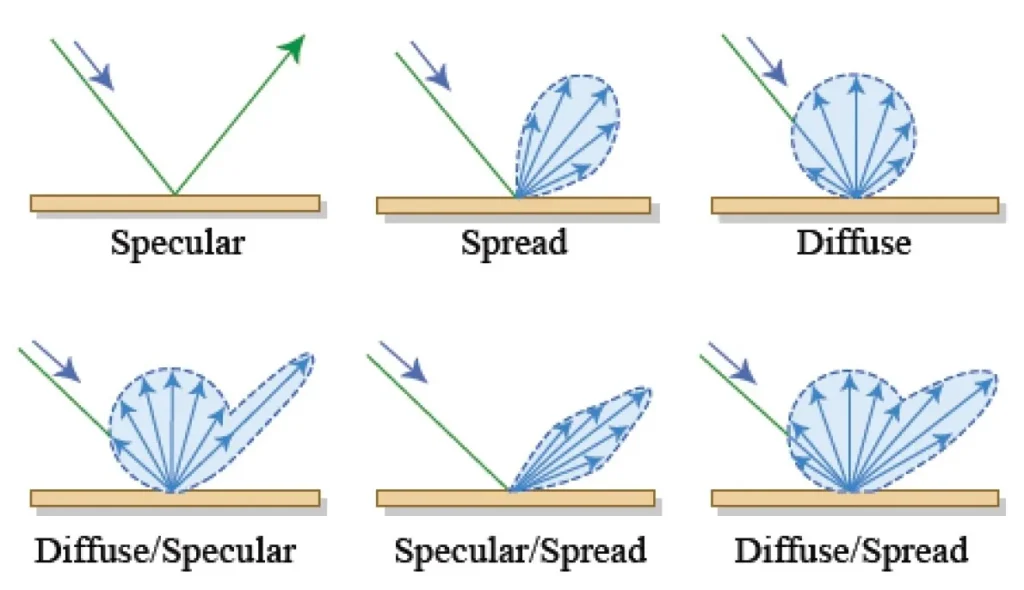
4) Photometric quantities
- The intensity of a light source – symbol: I, unit: candela (cd)
- Système International
- Defined as the intensity of a 1/60 cm2 uniformly emitting black body radiator at the melting point temperature of platinum- all other units are derived from this.
- The flux (or flow) of light: symbol F, unit lumens (lm)
- One lumen is the flow of light emitted by a unit intensity (1 cd) point source, within a unit solid angle.
- As the surface of a sphere subtends at its centre 4π ( = 56) units of solid angle, a 1 cd point source will emit a total of 12.56 lm in all directions.
- Luminance (symbol: L) is the measure of brightness of a
- If a light source of 1 cd intensity has a surface are of 1 m2 its luminance is 1 cd/ m2. This is SI unit.
- If a completely reflecting and diffusing surface (r= 00) has an illumination of 1 lux, its luminance is 1 asb (apostilb)
- 1 cd/ m2= 14 asb
- Illumination (symbol E) is measured as the amount of flux falling on unit area, e. lm/ m2 which is the lux, the unit of illumination in the SI unit.
- Illumination of a surface from several sources will be simple sum of the component illuminations:
- E=E1+E2+E3…..
- Illumination from a point source reduces with the square of the
- Illumination from a linear source of infinite length reduces in direct proportion to the distance (and not the square of distance) and from an infinitely large luminous surface (e.g. the sky) the illumination does not vary with the distance.
- A source of l candela emits a total flux of 4πl At a distance (d) this flux will be distributed over a sphere of radius d i.e. a surface of 4 π d2.

- Inverse square law, when the illuminated plane is normal (perpendicular) to the direction of light, i.e. angle of incidence is β=0°
- When the plane is tilted, the illumination is reduced.

En = illuminance on a normal plane
Eβ= illuminance on a plane tilted by β
- The eye responds to a range of illumination levels extending over a million orders of magnitude
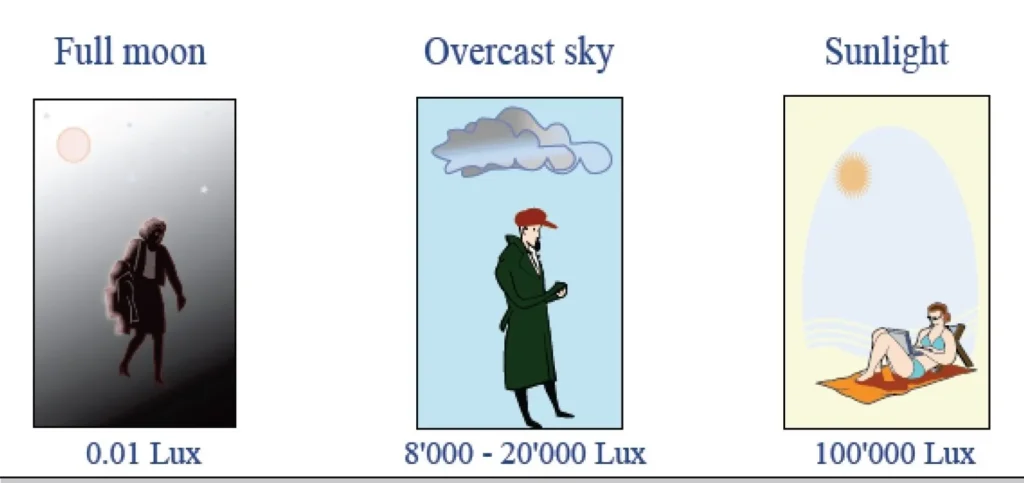
- The following values (in lux) can provide some general guidance:
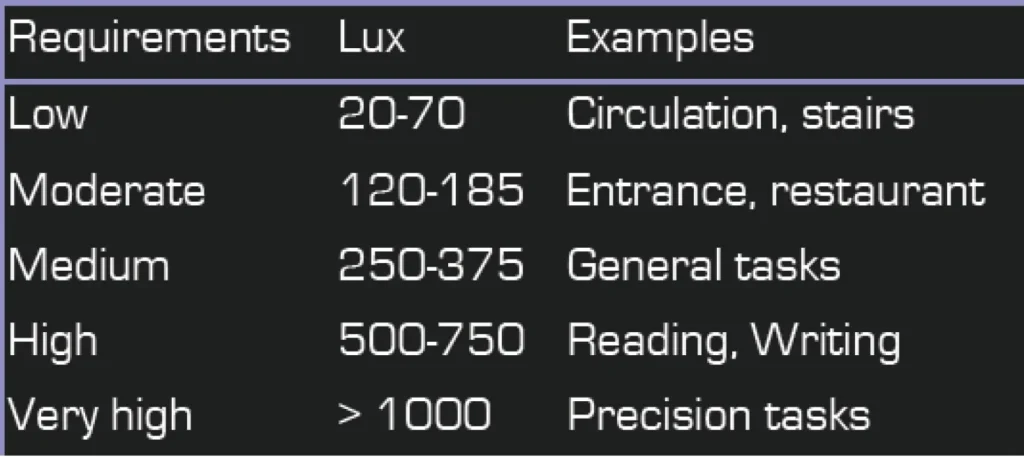
5) Illumination quality
In lighting design, the designer must ensure light which is both adequate and suitable for the visual task. Suitability in this context would mean the following qualities:
- Colour of light
- Good colour rendering
- Light distribution (direct or diffuse; modelling)
- Freedom from glare, no direct “glare”
- Luminance distribution (consideration of surface qualities together with the lighting of these surfaces) No “disturbing reflections” No strong “contrasts” Adequate “light levels”
6) Daylighting
- Source of light
- Light may reach a point inside a building from the sun the following ways
- Diffused or skylight, through a window or opening
- Externally reflected light (by the ground or other buildings), through the same windows
- Internally reflected light from walls, ceiling or other internal surfaces Direct sunlight, along a straight path from the sun, through a window to the given point.
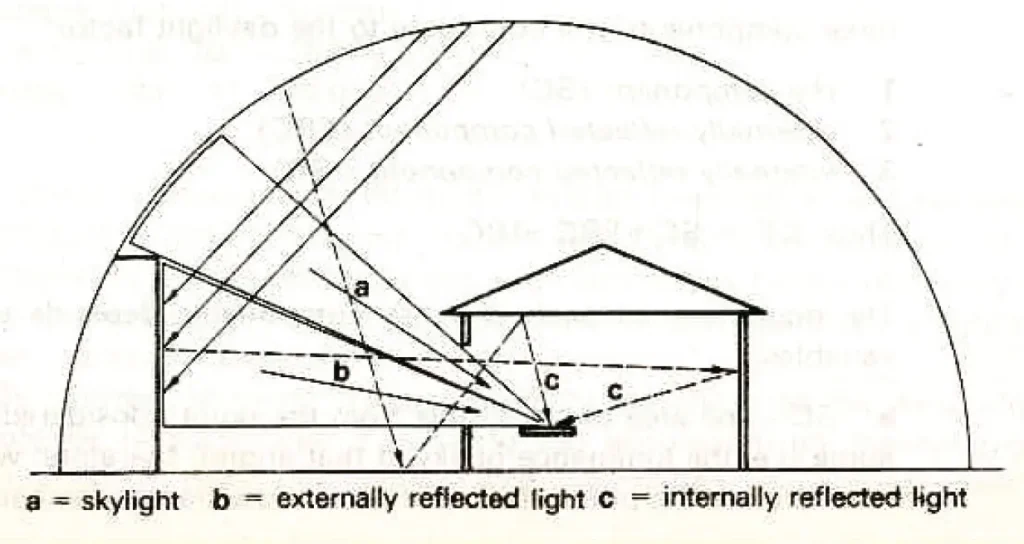
7) The daylight factor concept
- Due to variability of out-door lighting levels it is difficult to calculate interior lighting in photometric illumination terms.
- The daylight factor (DF): the ratio of the illumination to the simultaneous out-door illumination in percentage

Where
- Ei = illumination indoors, at the point taken
- Eo = illumination out-doors from an unobstructed sky hemisphere
8) Daylighting in Hot-dry climates
- Direct sunlight must be excluded from buildings partly for thermal reasons, partly as it would unavoidably create glare. As windows in this climate tend to be small, not much sky would be visible from any point indoors, thus, especially with low luminance blue skies, the sky component would be insufficient.
- On the other hand, luminance of the sky near the horizon is greater and it may be a source of glare if not screened.
- Both the ground and the external surfaces of other buildings are usually light coloured: in the strong sunshine these may also create glare.
- Therefore externally reflected light can only be used providing that great care is taken to avoid glare.
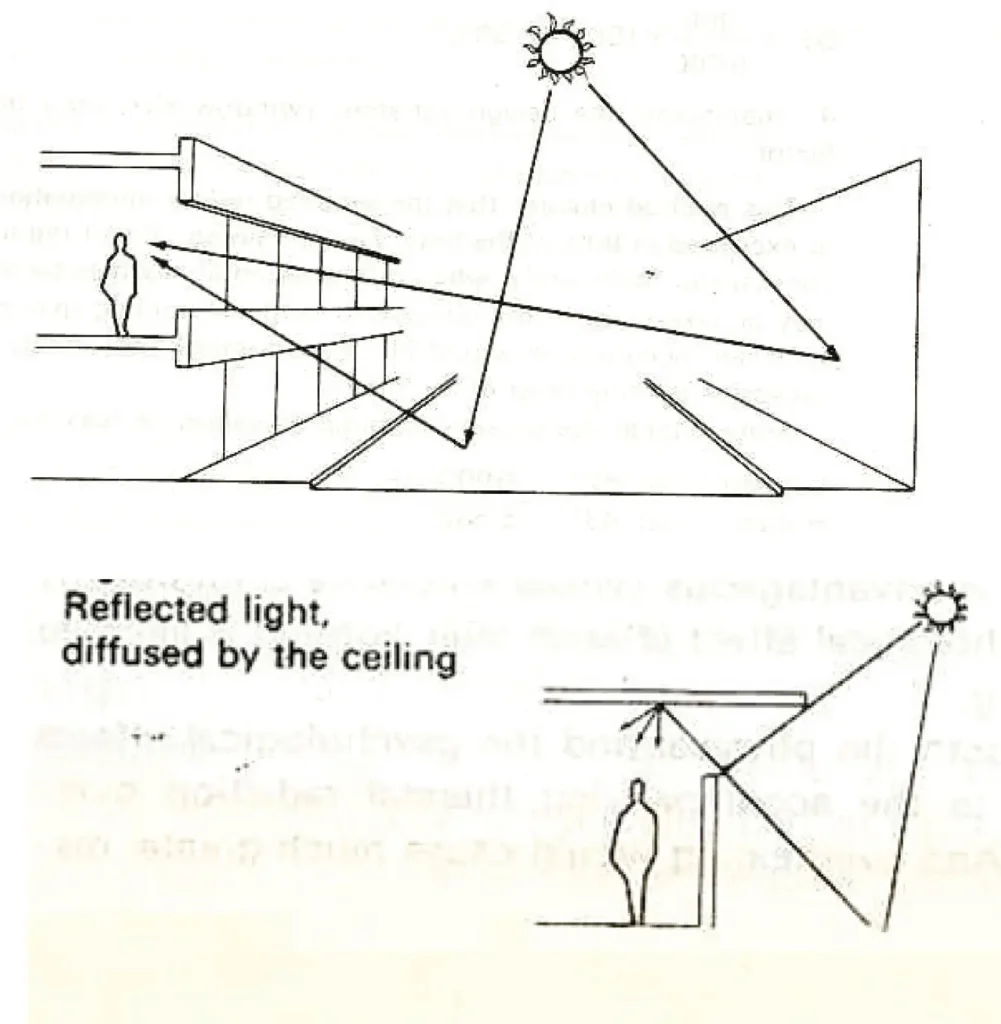
- Internally reflected light would be the most convenient form of daylighting. One suitable arrangement is a high level window (with cill above eye-level), which would admit reflected light to the ceiling. If the ceiling is white, this method would ensure adequate and well diffused interior lighting, through a comparatively small window.
- If shading devices are used, sunlit reflective surfaces of these devices can themselves become sources of glare. These surfaces should either be non-reflective, or positioned so that they are not directly visible.
- Low level windows are acceptable if they open onto a shaded and planted
- When a sunlit view through a window is unavoidable, the strong luminance contrast between the view and the window surround can be reduced by:
- painting the adjacent wall a light colour
- painting the inside of window frames white
- as the walls tend to be thick in this climate, the deep reveals should be splayed (and light coloured) to provide contrast grading
- other openings may be placed in opposite or flanking walls, to throw some light onto the wall surrounding the window.
- One solution for the avoidance of an excessively bright view is the use of a vertical strip-window at the corner of the room. This would throw light onto the wall surface (as a ‘wash’) thus providing a larger apparent source of a lesser luminance.
9) Daylighting in warm-humid climates
- Buildings in these climates are typically of lightweight construction, with large openings to ensure cross-ventilation and air movement usually with wide overhanging eaves or other shading devices.
- Direct sunlight is excluded for thermal the sky is bright could provide sufficient light, but its high luminance would also cause glare.
- For this reason, view of the sky should be screened by shading devices or As, however. the sky luminance is much less near the horizon than at higher altitude angles, a view of the sky up to about 15° from the horizon may be permissible.
- Thus, specific requirements for the design of shading devices.
- The criteria can be as follows:

- permit view of sky and ground near the horizon only, within about ±1 5° (up and down)
- exclude view of bright ground and sunlit blade or louvre surfaces
- daylight is to be reflected from ground and blades up to the ceiling, which itself should be of a light colour.
10) Daylighting in moderate climates
- In moderate climates it is practically impossible to provide adequate daylight (DF = 2%) in side-lit rooms, to a depth greater than three times the window head height (above the working plane).
- In an average office or class-room this would correspond to a depth of 6 m (max.). For rooms deeper than this, a system has been developed, known as PSALI, (permanent supplementary artificial lighting of the interiors).
- With this, as the name implies, the interior parts of the room are lit permanently by electric lights, to provide the necessary illumination in such a way that the overall impression of day-lighting is maintained.
- From this it was only one step to the use of PAL (permanent artificial fighting), which ignores daylight altogether, possibly leading to windowless environments.
11) Artificial Lighting
i) General lighting systems
- Lighting systems that provide an approximately uniform illuminance over the whole working plane are called general lighting systems.
- The luminaires are normally arranged in a regular layout, and the appearance of the installation is usually tidy but may be rather bland.
- General lighting is simple to plan using the lumen method and requires no coordination with task locations.
- A general lighting system employs a regular array of luminaires to provide a uniform illuminance across the working plane.

ii) Localised lighting
- Localized lighting systems employ an arrangement of luminaries designed to provide the required maintained illuminance on work areas together with a lower illuminance for the other areas.
- The average illuminance for the other areas should not be less than one-third of the average illuaminance over the work areas.
- The lighting layout must be coordinated with the task positions and orientation.
- The system can be inflexible, and information on plant and furniture layout is essential at the design stage.
- Changes in the work layout can seriously impair a localized system, although uplighters and other easily relocatable systems or energy management controls can overcome these problems.
- Localized systems normally consume less energy than general lighting systems unless a high proportion of the area is occupied by workstations.
- Maintenance of localized systems can be more critical than with general lighting systems.
- A Localized lighting system uses luminaries located adjacent to the workstations to provide the required task illuminance.
- The necessary ambient illuminance in the surrounding areas is provided by additional luminaries if required.

iii) Local/task lighting
- Local lighting provides illumination only over the small area occupied by the task and its immediate surroundings.
- A general lighting system must be installed to provide sufficient ambient illumination for circulation and non-critical tasks.
- This is then supplemented by the local lighting system to achieve the necessary design-maintained illuminance over the task areas.
- The general surround average illuminance should not be less than one-third of the average task illuminance.
- Local lighting can be very efficient method of providing adequate task illuminatin, particularly where high illuminances are necessary or flexible directional lighting is required.
- Local lighting is frequently provided by luminaries mounted at the workplace in offices and factories.
- Local lighting must be positioned to minimise shadows, veiling reflections and glare.

- A local lighting system employs a general lighting scheme to provide the ambient illuminance for the main area, with additional luminaries located at the workstations to provide the necessary task illuminance.
Daylighting design refers to the integration of natural light into a building to provide visual comfort and to reduce the energy consumption for artificial lighting. The following are some of the key principles of daylighting design:
- Maximize access to daylight: This involves placing windows and skylights strategically to allow for maximum penetration of natural light into a building.
- Control direct sunlight: Direct sunlight can cause glare and discomfort. It is important to control it through shading devices such as louvers, blinds, or overhangs.
- Reduce light loss: Light can be lost through reflections, absorption and scattered light. Using low-emissivity (Low-E) coatings on windows and glazing can help reduce this loss.
- Balance artificial and natural light: Natural light should be balanced with artificial light to provide consistent illumination levels and avoid over-reliance on artificial lighting.
- Consider the orientation of the building: The orientation of a building and its windows affects the amount and quality of natural light that enters the building.
- Integrate daylighting with electric lighting: Daylighting and electric lighting should be integrated to provide the desired lighting levels and to avoid conflicts between the two.
- Use daylight to enhance the architecture: Daylighting can be used to create a unique and memorable architectural experience.
- Minimize environmental impact: Daylighting design should consider its impact on the environment and minimize the carbon footprint of a building.
By incorporating these principles into the design of a building, it is possible to create a space that is comfortable, energy efficient, and aesthetically pleasing.